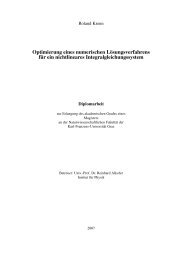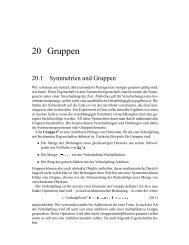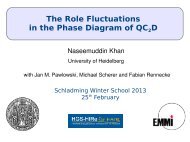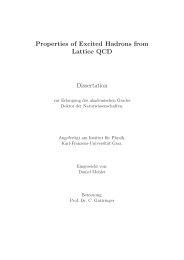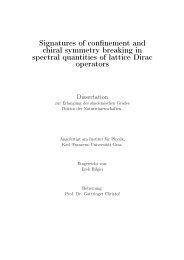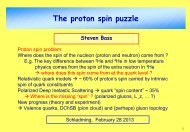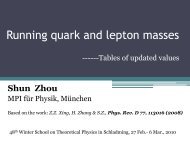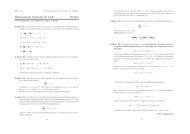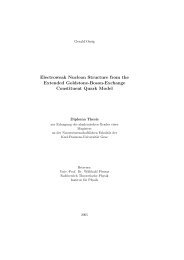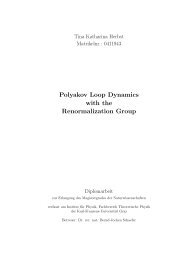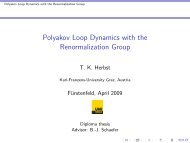The QCD Quark Propagator in Coulomb Gauge and - Institut für Physik
The QCD Quark Propagator in Coulomb Gauge and - Institut für Physik
The QCD Quark Propagator in Coulomb Gauge and - Institut für Physik
You also want an ePaper? Increase the reach of your titles
YUMPU automatically turns print PDFs into web optimized ePapers that Google loves.
66 6.3. Covariant Faddeev equation<br />
6.3.3 Solv<strong>in</strong>g the Faddeev equation <strong>and</strong> choices for nucleon <strong>and</strong><br />
∆ masses<br />
All elements of the Faddeev equations, equations(6.19) <strong>and</strong> (6.27), are now completely<br />
specified. We solve the equations via the method described <strong>in</strong> reference[OVSA02]. <strong>The</strong><br />
masses of the scalar <strong>and</strong> axial-vector diquarks are the only variable parameters. <strong>The</strong><br />
axial-vector mass is chosen so as to obta<strong>in</strong> a desired mass for the ∆, <strong>and</strong> the scalar mass<br />
is subsequently set by requir<strong>in</strong>g a particular nucleon mass.<br />
Two parameter sets are presented <strong>in</strong> table 6.1. We obta<strong>in</strong>ed set A by requir<strong>in</strong>g a precise<br />
fit to the experimental nucleon <strong>and</strong> ∆ masses. It has long been known that this is possible:<br />
reference [OHAR98] reports octet <strong>and</strong> decuplet baryon masses <strong>in</strong> which the rms deviation<br />
between the calculated mass <strong>and</strong> experiment is only 2%. However, it is also known that<br />
such an outcome is undesirable because, e.g., studies us<strong>in</strong>g the cloudy bag model <strong>in</strong>dicate<br />
that the nucleon’s mass is reduced by as much as δM N = −300 to −400 MeV through<br />
pion self-energy corrections [PA86]. Furthermore, a perturbative study, us<strong>in</strong>g the Faddeev<br />
equation, of the mass shift <strong>in</strong>duced by pion exchange between the quark <strong>and</strong> diquark<br />
constituents of the nucleon obta<strong>in</strong>s δM N = −150 to −300 MeV [Ish98]. We are thus led<br />
to set B, which was obta<strong>in</strong>ed by fitt<strong>in</strong>g to nucleon <strong>and</strong> ∆ masses that are <strong>in</strong>flated so as to<br />
allow for the additional attractive contribution from the pion cloud [H + 02].<br />
It is apparent <strong>in</strong> table 6.1 that a baryon’s mass <strong>in</strong>creases with <strong>in</strong>creas<strong>in</strong>g diquark<br />
mass, <strong>and</strong> the fitted diquark mass-scales are commensurate with the anticipated values, cf.<br />
equation(6.40), with set B <strong>in</strong> better accord. If coupl<strong>in</strong>g to the axial-vector diquark channel<br />
is omitted from equation(6.19), then MN<br />
set A = 1.15 GeV <strong>and</strong> MN<br />
set B = 1.46 GeV. It is thus<br />
clear that axial-vector diquark correlations provide significant attraction <strong>in</strong> the nucleon. Of<br />
course, us<strong>in</strong>g our Faddeev equation, the ∆ does not exist without axial-vector correlations.<br />
Table 6.1: Mass-scale parameters (<strong>in</strong> GeV) for the scalar <strong>and</strong> axial-vector diquark correlations,<br />
fixed by fitt<strong>in</strong>g nucleon <strong>and</strong> ∆ masses: for set A, a fit to the actual masses was<br />
required; whereas for set B the fitted mass was offset to allow for “pion cloud” contributions<br />
[H + 02]. We also list ω J P = 1 √<br />
2<br />
m J P, which is the width-parameter <strong>in</strong> the (qq) J P<br />
Bethe-Salpeter amplitude, equations(6.43) <strong>and</strong> (6.44): its <strong>in</strong>verse is a measure of the<br />
diquark’s matter radius.<br />
set M N M ∆ m 0 + m 1 + ω 0 + ω 1 +<br />
A 0.94 1.23 0.63 0.84 0.44=1/(0.45fm) 0.59=1/(0.33fm)<br />
B 1.18 1.33 0.79 0.89 0.56=1/(0.35fm) 0.63=1/(0.31fm)



